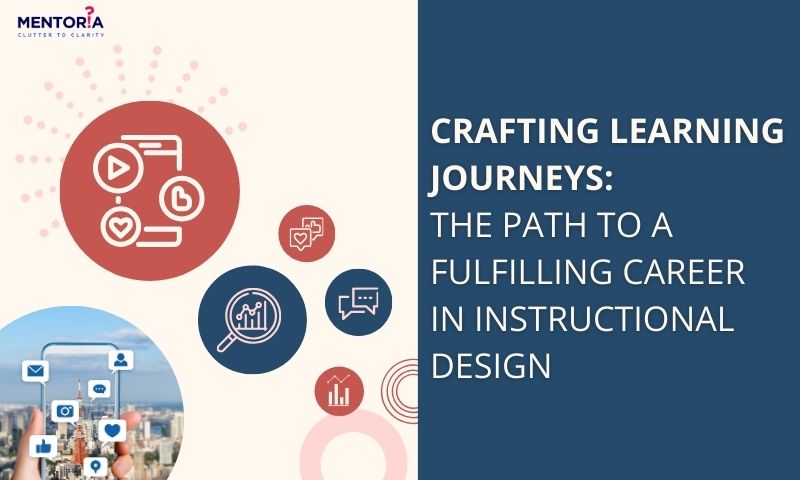Crafting Learning Journeys: The Path To A Fulfilling Career In Instructional Design

Ever wondered how those captivating online courses or mind-blowing training programmes come to life? Welcome to a career in instructional design – where education meets innovation! Get ready for a journey behind the scenes, as we unravel the secrets of instructional design. This blog is a guide to crafting learning experiences that leave a lasting impact. Whether you’re a curious learner or aspiring to shape the future of education, we’re about to dive into a world where every lesson is a masterpiece waiting to happen.
Building A Career In Instructional Design
What Is Instructional Design, Anyway?
Instructional design is the systematic process of creating effective educational experiences. It involves the analysis of learning needs and the design and development of instructional materials to meet those needs. The primary goal of instructional design is to enhance the learning experience and facilitate the acquisition of knowledge and skills in a structured and efficient manner.
In simpler terms, instructional design is like the architect of education. It’s about carefully planning and crafting the blueprints for learning experiences, considering the needs of the learners and the desired outcomes. Instructional designers use a variety of methods, tools, and technologies to create engaging and effective learning materials, such as courses, modules, or multimedia presentations.
- Striking a Balance: Instructional design is all about finding the sweet spot between education and engagement. It’s not just about pouring information onto pages; it’s about making that information meaningful and memorable.
- Adaptability Matters: Successful instructional designers wear many hats. They need to adapt their approach to suit different learners and create content that resonates across various demographics.
- Technology Integration: In the digital age, instructional designers leverage technology to create interactive and immersive learning experiences. It’s about utilising tools that enhance engagement and understanding.
- Measuring Impact: Instructional design is results-oriented. It’s not just about creating content; it’s about gauging its effectiveness. Successful instructional designers continually evaluate and refine their methods to ensure optimum impact.
Qualifications For Becoming An Instructional Designer
Entering the world of instructional design requires a roadmap. While there’s no magic spell, having the right qualifications is your key. Most roles demand a bachelor’s degree in education, instructional design, or a related field. Some professionals take it up a notch with master’s degrees, gaining a deeper understanding of the field.
- Bachelor’s Basics: A foundational degree in education or instructional design is often the first step. It equips you with the fundamental principles that underpin effective learning experiences.
- Mastering the Craft: Pursuing a master’s degree allows for a deeper dive into the intricacies of instructional design. It’s about honing your skills, exploring advanced methodologies, and gaining a comprehensive understanding of the field.
- Certificates Count: For those looking to enter the field swiftly, certificate programmes offer a focused and accelerated path. Many professionals start with certificates before venturing into more extensive academic pursuits.
- Continuous Learning: The world of instructional design is ever-evolving. Beyond formal qualifications, successful professionals engage in continuous learning, staying abreast of new methodologies and technologies.
Educational Landscape: Where To Hone Your Skills
Wondering where to start your instructional design journey? Numerous universities worldwide offer comprehensive programmes. It’s not just about the degree; it’s about practical application and real-world readiness.
India:
- IGNOU – Indira Gandhi National Open University, New Delhi: IGNOU offers a Master’s degree in Distance Education (MADE) with a specialisation in instructional design.
- Symbiosis Centre for Distance Learning (SCDL), Pune: SCDL provides a Post Graduate Diploma in Instructional Design for eLearning.
- Indian Institute of Technology (IIT) Bombay, Mumbai: IIT Bombay offers a blended programme in Instructional Design for Educators, combining online and face-to-face sessions.
- Amity University, Noida: Amity offers a Master’s programme in Instructional Design.
- Banaras Hindu University (BHU), Varanasi: BHU provides a Certificate programme in Instructional Design.
Abroad:
- University of Georgia, USA: The University of Georgia offers a Master’s degree in Learning, Design, and Technology with a focus on instructional design.
- University of Colorado Denver, USA: This university provides a Master of Arts in Information and Learning Technologies with a concentration in eLearning Design and Implementation.
- Harvard Extension School: Renowned for its diverse and flexible programmes, Harvard Extension School offers a range of courses in instructional design. It’s an ideal choice for those seeking a well-rounded educational experience.
- Full Sail University: Known for its emphasis on technology and creativity, Full Sail University provides programmes that integrate instructional design with cutting-edge tools and techniques.
- Symbiosis Center for Distance Learning: Closer to home, Symbiosis in India offers distance learning courses in instructional design, allowing for flexibility for working professionals or those who prefer remote learning.
- Online Platforms: Platforms like Coursera and Udemy offer a plethora of courses in instructional design. They provide a practical and accessible way to learn, especially for those looking to acquire specific skills.
Companies That Call For Instructional Designers Today
The demand for instructional designers spans across industries, with companies actively seeking professionals who can transform information into engaging learning experiences.
- Tech Giants: Companies like IBM, Amazon, and Google are at the forefront of hiring instructional designers. The tech industry values individuals who can create innovative and interactive learning materials.
- Consulting Firms: Consulting firms like Deloitte recognise the importance of effective training. They often seek instructional designers to develop impactful learning programmes for their clients.
- E-Learning Platforms: Platforms like Udacity, Coursera, and Khan Academy are always on the lookout for instructional designers to enhance the quality and effectiveness of their online courses.
- Healthcare and Pharmaceuticals: Industries such as healthcare and pharmaceuticals value instructional designers to create training programmes that ensure compliance, safety, and continuous professional development.
Instructional designers are in high demand for several compelling reasons, reflecting the evolving landscape of education, training, and technology. Here are key factors contributing to the increased demand for instructional designers:
- Rise in Online Education: With the proliferation of online learning platforms, educational institutions, and corporate training programmes shifting to digital formats, the demand for instructional designers has surged. These professionals play a crucial role in translating traditional content into engaging and effective online formats.
- Technology Integration: The integration of technology in education has become a cornerstone of modern learning. Instructional designers are needed to leverage various technologies, such as Learning Management Systems (LMS), interactive multimedia, and virtual reality, to create immersive and dynamic learning experiences.
- Personalised Learning: The recognition of diverse learning styles and the need for personalised learning experiences have increased. Instructional designers are tasked with creating content that caters to individual learners, ensuring that educational materials are adaptable and accessible to a wide audience.
- Corporate Training and Development: Organisations recognise the importance of continuous learning for their employees. Instructional designers are essential in developing training programmes that align with organisational goals, enhance employee skills, and contribute to overall business success.
- Focus on Outcome-Based Education: There’s a growing emphasis on outcome-based education, where the focus is not just on the delivery of content but on measurable learning outcomes. Instructional designers design curricula and assessments that align with specific learning objectives and desired results.
- Globalisation of Education: The globalisation of education and corporate operations has increased the demand for instructional designers who can create content that is culturally sensitive and applicable across diverse regions and demographics.
Decoding Salaries Of An Instructional Designer
Now, let’s talk about everyone’s favourite topic: money. Salaries in instructional design vary based on experience and location. Entry-level positions may range from INR 3-5 lakhs annually, while seasoned professionals can command upwards of INR 10 lakhs or more.
- Entry-Level Earnings: Fresh graduates or those entering the instructional design field can expect a decent starting salary, typically ranging from INR 3 to 5 lakhs annually. It provides a solid foundation for building experience and skills.
- Mid-Level Milestones: As you climb the professional ladder, your earning potential increases. Mid-level instructional designers with a few years of experience can command competitive salaries, averaging between INR 6 to 8 lakhs annually.
- Senior Strategists: Senior instructional designers or those in leadership roles often enjoy the highest salaries. Their extensive experience and strategic contributions to the field are duly rewarded, with earnings reaching INR 10 lakhs or more annually.
- Industry Impact: Salaries also vary based on the industry. For example, working in tech hubs like Bangalore or Hyderabad may offer higher compensation due to the demand for instructional designers in these regions. Salaries for experienced professionals in such regions can surpass INR 15 lakhs annually or more.
Career Progression For An Instructional Designer
The beauty of instructional design lies in its continuous evolution. From e-learning specialist to instructional design manager, there’s room for growth. Climbing the ladder often brings not just a fatter paycheck but also the satisfaction of influencing broader educational strategies.
- Specialisation Opportunities: As you progress, you can choose to specialise in areas like multimedia design, game-based learning, or corporate training, opening doors to new and exciting opportunities.
- Management Roles: Instructional design managers oversee teams and projects. It’s a role that involves not just content creation but strategic planning and leadership.
- Consulting and Entrepreneurship: Seasoned instructional designers may choose to venture into consulting or even start their own instructional design firms, offering expertise to a broader clientele.
- Contributions to Education: Some professionals transition into roles within educational institutions or organisations, contributing to the development of curriculum and educational policies.
Crafting Tomorrow’s Learning Experiences
In wrapping up our exploration of instructional design, remember that this field is a dynamic fusion of creativity, technology, and education. It’s about crafting learning experiences that leave a lasting impact. Whether you’re just starting or looking to level up your skills, instructional design offers a canvas for continuous learning and growth. So, dive in, explore, and let your creativity shape the future of education.
Ready to embark on your instructional design journey? Mentoria’s personalised career guidance can be your compass. Mentoria’s career guidance programme enables you to choose your perfect fit from 3 streams, 850+ courses, and 12,000+ careers, and discover what will bring out the best in you.









